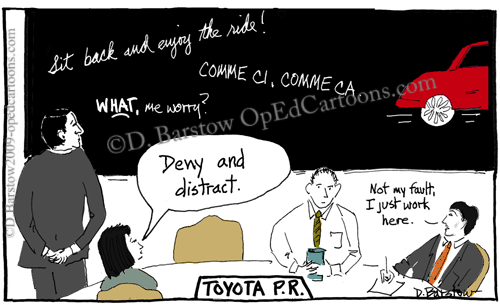In communications, two people can completely agree or disagree on any concept. This wide range of misunderstanding and conflict is the price we pay for being human. In public relations, when vague or imprecise concepts are made into more specific and precise ideas it is called conceptualization.
Say I want to conceptualize Toyota’s recall, one indicator of this recall could be that Toyota had to comply with the United States government or the second indicator could be that the company felt it was their moral responsibility. Nonetheless, the fact of the matter is Toyota has made 5 million repairs to their vehicles within the U.S. in 2010. Therefore, instead of selling cars, the company has spent this past year fixing them.
Last week I stated that Toyota should not have to accept responsibility for human error. However, this week I am going to play the devil’s advocate. There are two sides to every story and am willing to uncover why, if Toyota is innocent, they fixed so many faulty vehicles.

Indicator one: According to CBS News, Toyota started to receive heat from the United States Congress back in February of 2010. The company received a subpoena from a federal grand jury in New York seeking documents related to unintended acceleration in Prius hybrid vehicles and their braking system. Shortly following, Toyota also received a subpoena and voluntary document request from the Los Angeles office of the U.S. Securities and Exchange Commission about the unintended acceleration and disclosed policies.
More surprisingly, Toyota claimed in internal documents that it saved money by obtaining a limited recall from regulations in 2007 by negotiating an “equipment recall” of floor mats involving 55,00 Toyota Camry and Lexus ES350 vehicles. These documents also cited millions of dollars in additional savings by delaying safety regulations, avoiding defect investigations and slowing down other industry requirements. In response to Toyota’s negligence, the U.S. government fined the company $16.4 million, for hiding problems that could be the reason for dozens of deadly crashes.
Indicator two: According to Toyota’s North America Chief Quality Officer, Steve St. Angelo, recalls are an integral part of ensuring product safety and standing by their customers:
“Over the long-term, Toyota has built a record of safety, reliability and quality that’s unquestionably strong – and we’ve made significant changes at Toyota in the past several months to make sure we are an even more responsive, safety-focused organization. We’re listening closely to our customers and taking quick, decisive actions to ensure their vehicles are safe. Our strengthened quality assurance team is leaving no stone unturned as it thoroughly examines our entire fleet, including millions of cars and trucks that have performed reliably for more than a decade" (read full press release here).
Say I want to conceptualize Toyota’s recall, one indicator of this recall could be that Toyota had to comply with the United States government or the second indicator could be that the company felt it was their moral responsibility. Nonetheless, the fact of the matter is Toyota has made 5 million repairs to their vehicles within the U.S. in 2010. Therefore, instead of selling cars, the company has spent this past year fixing them.
Last week I stated that Toyota should not have to accept responsibility for human error. However, this week I am going to play the devil’s advocate. There are two sides to every story and am willing to uncover why, if Toyota is innocent, they fixed so many faulty vehicles.

Indicator one: According to CBS News, Toyota started to receive heat from the United States Congress back in February of 2010. The company received a subpoena from a federal grand jury in New York seeking documents related to unintended acceleration in Prius hybrid vehicles and their braking system. Shortly following, Toyota also received a subpoena and voluntary document request from the Los Angeles office of the U.S. Securities and Exchange Commission about the unintended acceleration and disclosed policies.
More surprisingly, Toyota claimed in internal documents that it saved money by obtaining a limited recall from regulations in 2007 by negotiating an “equipment recall” of floor mats involving 55,00 Toyota Camry and Lexus ES350 vehicles. These documents also cited millions of dollars in additional savings by delaying safety regulations, avoiding defect investigations and slowing down other industry requirements. In response to Toyota’s negligence, the U.S. government fined the company $16.4 million, for hiding problems that could be the reason for dozens of deadly crashes.
Indicator two: According to Toyota’s North America Chief Quality Officer, Steve St. Angelo, recalls are an integral part of ensuring product safety and standing by their customers:
“Over the long-term, Toyota has built a record of safety, reliability and quality that’s unquestionably strong – and we’ve made significant changes at Toyota in the past several months to make sure we are an even more responsive, safety-focused organization. We’re listening closely to our customers and taking quick, decisive actions to ensure their vehicles are safe. Our strengthened quality assurance team is leaving no stone unturned as it thoroughly examines our entire fleet, including millions of cars and trucks that have performed reliably for more than a decade" (read full press release here).

When it comes down to statistics, of the total number of repaired vehicles, 1.8 million cars had problems with sticky accelerator pedals, 3.1 million with mats that could trap the pedal and about 128,000 cars needed new or fixed antilock-brake systems, in some 2010 Prius and Lexus models. In the court of law, you are innocent until proven guilty. My final verdict: According to the facts, Toyota you’re 100% guilty of selling unsafe automobiles. You better get your public relations team together quick, because they are going to have to perform a miracle in order to regain public trust and save the company’s reputation.
Catch ya same time next week!!
No comments:
Post a Comment